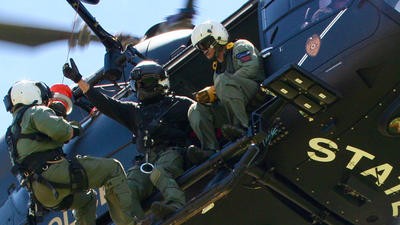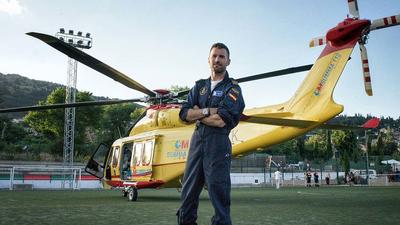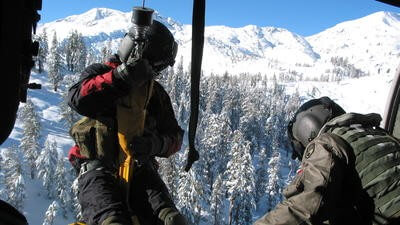High-altitude rescues – considerations and concerns

Barry Smith shares insights from experts taking on the ultimate challenge for rescue crews – rescue at high altitude, where aircraft and crew are pushed to the limit
It is a black and white world of icy temperatures and steep rock faces divided by huge glaciers. Hurricane-force winds and little oxygen plague its temporary inhabitants. This sounds like an introduction to a science fiction movie, doesn’t it? It’s not. It is an accurate description of the conditions encountered by rescue teams during extreme high-altitude missions.
The Alaskan mountains span 650 km of central Alaska in the US, with dozens of peaks over 3,300 m. The highest, Denali, pierces the sky up to 6,200 m. Located within Denali National Park, this peak is the highest in North America and a popular climbing destination. A small team of National Park Service mountaineering rangers, aided by a civilian contract helicopter, respond to injuries and illness on the mountain.
Performing rescues in a high-altitude environment forces crews to go back to the basics for patient care and rescue. There are, in many cases, tremendous patient treatment capabilities on the mountain. But crews have to think about what is needed in terms of equipment to quickly stabilize the patient and get them off the mountain and out of that high-altitude situation. A healthy person does not do well at extreme altitudes. When they are sick or hurt, they do much worse. Getting them off the mountain to definitive care is the most important thing we can do for our patients.
“A big part of our program has been to always have some acclimatized rangers on the mountain for the entire climbing season, which is typically April through to July,” explained David Weber, one of the mountain rangers. “There are five camps on the mountain that are used by climbers. Rangers are spread throughout those camps. There is a full-time ranger presence at two of those camps, with a robust supply of medical and rescue equipment. One is at the base camp, where all the climbers fly into a glacier at 2,200 m. The other is located at 4,300 m. There is another cache of medical and rescue gear at 5,200 m that is staffed with rangers when they are able.”
These rangers train for five to six weeks every year on mountaineering, medical and rescue techniques prior to the start of the climbing season. This also includes helicopter training. It usually takes about one to two years to become a fully qualified member of the helicopter rescue team. The goal is for all mountaineering rangers to be helicopter-rescue qualified. They perform about 25 to 30 rescue missions per season.
The park has a contract with Temsco Helicopters to provide a rescue helicopter during the climbing season. For the past 11 years, the only rescue pilot has been Andreas Hermansky. He is brought into the planning stage for a rescue as soon as possible so he can have input on the plan. Over the years, the rangers and Hermansky have developed a very close personal and professional working relationship. His input is considered crucial for rescue planning.
“There is a great deal of trust between the pilot and the rangers,” stated Weber. “Working in an environment at the edge of human and machine limitations makes this very important. The team has a tremendous amount of institutional knowledge of high-altitude rescue techniques.”
The ultimate challenge, and single greatest limiter for the rescue team on the mountain, is the weather. It is about 100 km from the ranger station at Talkeetna to Denali. In addition, any rescuers responding from the station are going from sea level to 6,000 m at the top of Denali. There can be tremendous shifts in the weather over that distance and altitude change. Temperatures on the mountain can range from -40°C to 0°C. During a storm, 50- to 65-kph winds are normal, and it is not unusual to see 110 kph or greater wind speeds on the upper mountain.
If they can, it is preferable to use the rangers on patrol on the mountain for rescue missions because they are acclimatized to the altitude. The pilot has an oxygen system in the helicopter that he uses at altitude. If it is not possible to use rangers already on Denali, rangers coming from Talkeetna will take medications, diamox and dexamethazone, to mitigate the effects of altitude and help prevent altitude sickness. They will also carry an oxygen system that will give them about 24 hours of supplemental oxygen.
If the helicopter can’t land, the team is proficient in toe-in and one skid landings
If the helicopter can’t land, the team is proficient in toe-in and one skid landings, as well as hover stepping into and out of the helicopter. The other option is to do a short-haul rescue. The thinking about mountain rescue using helicopters is changing. Unless the helicopter can do a power off landing, it is becoming preferable to do a short haul. The idea is to keep a hovering helicopter as far away from terrain as possible to reduce the risk of rotor blade contact.
The team will fly a reconnaissance flight once they reach the scene of the rescue to fine tune the rescue plan and do power checks on the helicopter to make sure it has the necessary performance. The helicopter would then return to the staging area to reconfigure the aircraft for the chosen rescue technique. In addition, the risk assessment is down again to confirm the risks are acceptable.

Some US Army CH-47 Chinook units have written agreements with several national parks for high altitude rescues. © Barry Smith
The rangers have a very close working relationship with different military aviation units, both helicopter and fixed wing. The fixed-wing units, using C-130 and C-17 transports, can be used for locating victims and as a communications relay station. Their large fuel load allows them to loiter over the mountain for many hours. The helicopters can be used during rescue missions involving a large number of victims or to transport numerous rescuers and equipment to staging sites.
Another way the military co-operates with the Denali rangers is to assist with setting up the camps at the beginning of the climbing season and tear down at the end of the season. The US Army’s CH-47 Chinook has excellent high-altitude performance, and can carry several tons of equipment either internally or in a cargo net as a sling load. The benefit to the rangers is obvious, but it is also of great benefit to the helicopter unit, as it allows them practical experience at extreme altitudes that they would otherwise not be able to obtain.
There is an exchange program with Nepalese climbers that perform rescues on Mt Everest funded by a charitable organization. Weber and other mountaineering ranges have travelled to Nepal to teach rescue techniques. Each year, one or two Nepalese rescue mountaineers spend time at three or four National Parks, including Denali, shadowing mountain rescue teams. This has been going on for over 10 years and has been deemed to be a very successful exchange of information for both sides.

Preparing Horizon Helicopter’s AS350B3e for a short-haul rescue in Kluane National Park. © Parks Canada.
“The current helicopter used is an Airbus H125,” explained Hermansky. “The helicopter has been modified to reduce weight. There is no front seat next to the pilot. There is a fixed oxygen system installed with two outlet ports. The instrument panel is the smallest one possible. There are no cushions for the seats. There are intercom boxes located outside the helicopter so the rangers can plug into them to talk with the pilot. All excess wiring was also removed. The heavy rubber flooring has been removed and replaced with anti-skid tape. The aircraft cannot get any lighter. Overall, we have removed about 100 kg of weight.”
fuel management keeps the weight of the aircraft as light as possible
Hermansky has kept precise notes on the amount of fuel he has used on flights to Denali with records of the temperature, load, and the exact location where he has flown and amount of time at different altitudes. This knowledge allows him to accurately predict how much fuel he will need for a rescue on any part of the mountain. This fuel management keeps the weight of the aircraft as light as possible. For example, he knows the fuel burn at 18,000 ft at cruise power is 31-32 gallons per hour, where the normal fuel burn for the H125 is 45-50 gallons per hour. There is a fuel cache at the base camp on Denali, which can be used to extend the time on the mountain.
On overcast days or in shaded areas, the light is very flat, which makes depth perception difficult and landing a challenge. In addition, Hermansky stated he is operating, at times, in the bottom portion of the jet stream. He has to be very careful on the lee side of the mountains when he is at very high altitudes. The downdrafts could force the helicopter to descend beyond the performance capabilities of the helicopter to escape. Winds funneling through narrow gaps can reach 185 kph or more. He has learned to be very aware of the winds and how they interact with the mountain.

Horizon Helicopters is the contractor for helicopter rescues in Kluane National Park, Yukon Territory, Canada. © Parks Canada.
Just across the Alaskan border is Kluane National Park and Preserve, Yukon Territory, Canada. “Kluane has 20 of the highest mountains in Canada including Mt Logan, the highest peak in Canada at just under 6,000 m,” commented Scott Stewart, Kluane’s Visitor Safety Co-ordinator, who co-ordinates rescue responses within the park. “We use helicopters on 99 per cent of our rescue missions on Mt Logan and the ice fields due to the remoteness of these areas. The ice fields are about 15,000 km2 in size. The closest town is 180 km away. By helicopter, it takes one to one and a half hours to fly to the Mt Logan area. We do not have teams based on the mountain during the climbing season.”
Since the team is responding from low elevation, they use medications to help their bodies acclimatize faster and avoid some of the medical problems that can develop from sudden dramatic altitude gain. In addition, once any team members, including the pilots, go higher than 3,000 m, they go on supplemental oxygen and remain using oxygen until below that altitude. That includes any rescuers attached to the rope during a short-haul helicopter evolution. The rescue helicopter is equipped with an oxygen system and the rescuers carry small tanks in their packs.
Since the team is responding from low elevation, they use medications to help their bodies acclimatize faster
“Lately, we have been using a two-helicopter response for rescue missions,” explained Stewart. “Typically, they will fly to a staging area we use on the north side of Mt Logan located at an altitude of about 2,000 m. There is a small cabin located here with a fuel cache for the helicopters and a cache of first aid and rescue gear. There have been several times when the victim has been brought down to the staging cabin and had to stay there with the rescue team until the weather improves to fly them to a higher level of medical care. The cabin is set up to handle these situations. On other occasions, the rescue crew has to stage at the cabin until the weather improves enough to do the rescue.”
Using two helicopters is done for several reasons. One can be used as an observation platform to pinpoint the location of the victims and determine a good forward staging site for the helicopter that will be used for the rescue attempt. It can also be used to shuttle fuel into the staging area if necessary. It is also used as a communications relay between the rescue team and the incident command post at park headquarters.
All of the rescue personnel interviewed for this article stated that everyone on the team; the rangers, the pilots, and the helicopter mechanic, consider themselves as part of one team. There is a great deal of trust among them. It is a very strong bond that allows them to perform difficult missions in one of the harshest environments on earth.

December 2020
Issue
In this issue:
- MRO services – market adaptations and refinements
- High-altitude rescues – what does it take from crews and aircraft?
- Top challenges for air medical providers in 2021
- Burn care innovations – critical care transfer developments
- Onshore vs offshore rescues
- Keeping aircraft clean during Covid
Barry Smith
Barry Smith has been an aviation and emergency services writer/photographer for over thirty years. He has published over 250 magazine articles and six books. He has also worked in emergency services as a paramedic, volunteer firefighter, and member of search and rescue teams for over 40 years.




